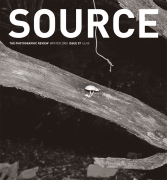Archival Fragments
Recent Finds – Sean Lynch – Gallery of Photography 25th September - 9th November 2008
Review by Doireann Wallace
Issue 57 Winter 2008
View Contents ▸
Faced with the mass circulation of photography in 1920s print culture, Siegfried Kracauer warned that this flood of images did not in any way aid memory, but threatened to wash it away. Such laments are endemic to modernity, where the speed of change is seen to sever the continuity of historical memory, and it is against the ensuing ‘cultural amnesia’ that Sean Lynch claims to pitch his work, concerned with forgotten historical subjects.
Such an effort is evident in the apparent centrality of Views of Dublin also published as a small booklet, to Lynch’s show. Occupying both the main gallery space and an adjacent room, a series of large, framed reproductions of half-tone newspaper images from the 1960s (with foreground and sky detail excised in what seems a predominantly aesthetic decision, connotations of construction notwithstanding) traces the convergence of two events: material from a replica of the Berlin Wall constructed in Smithfield in 1965 for the filming of cold war thriller The Spy Who Came in From the Cold is afterwards incorporated into the first Traveller’s school in Ireland, St. Christopher’s, built and run by civil rights activists and the community itself. The importance of the piece seemed to be underlined by the artist’s talk, a dialogue between Lynch and activist Grattan Puxon, who narrated his experiences of building St. Christopher’s, of rebuilding it after it was burnt down by Dublin Corporation, of constant evictions, and of facing the same opposition today in Essex, where he and many Traveller families relocated to, rebuilding the school. Views of Dublin is an intriguing sketch for a largely unfamiliar and unfinished history of the struggles of Ireland’s indigenous minority group for equal rights – but, disappointingly, it remains merely suggestive, indicating that a commitment to exploring such a history is beyond its sphere of interest.
The rest of the exhibition comprises diverse and unrelated fragments. Lynch unearths and documents the material traces of minor commemorative practices: an artist collects the chalk dust from a blackboard used by Joseph Beuys during a 1974 lecture in Cork after a local clergyman erases Beuys’s notes and drawings (elsewhere these boards are preserved as quasi-sacred relics); visitors over the years maintain a stone circle Richard Long constructed on the Aran Islands in 1979; a 1959 Frank Lloyd Wright design for a house in Maryland is finally realised in Greystones, its image now an ad on the back of the construction company’s van; a bronze golf ball is stolen from a statue marking Bill Clinton’s afternoon spent golfing in Ballybunion.
A sole exception to the Irish theme, one piece stands out as perhaps the true centrepiece of the show, shedding light on Lynch’s understanding of history. Displayed alone in a small room in the upstairs gallery is a recent colour photograph of the site of the hotel, in Portbou, Spain, where Walter Benjamin committed suicide as he attempted to flee Nazi-occupied Europe in 1940. The hotel is no longer there. The building has been gutted and is undergoing redevelopment. Flanked by tidy, freshly painted shops and apartments that appear to have been renovated themselves, with a large, shabby building, paint peeling badly, visible on the next street, the construction site represents a pivotal moment in the historical processes by which traces of the past are annihilated, plastered over, forgotten. It is a monument to the cultural amnesia to which Lynch offers his work as an antidote. But the image avoids the mute fait accompli of the archival document. The persistence of material traces of the past has become a genre unto itself in contemporary photographic practice due to the medium’s archival proclivities, but Lynch’s approach to the archive is equally interested in construction. The building is photographed during working hours. Two builders, frozen mid-job, raise a small cloud of dust as they cut into the outer wall. History, Lynch asserts, is not a done deal, but a productive articulation.

More importantly, the Benjamin image can be understood as Lynch’s own minor commemorative gesture, and provides a useful lens through which to view his practice. Benjamin’s rejection of the conception of an empty, homogeneous time implied in the notion of historical progress, and insistence that time be grasped as an image – arrested, rather than flowing – clearly informs Lynch’s propensity for discontinuous fragments over historical narratives, but what does such a strategy amount to? History is always the history of the victors, Benjamin observed, and everything that doesn’t have a place in this narrative, that isn’t recognised by the present as one of its own, is consigned to oblivion. To produce (revolutionary) history is thus to connect with the present of a past moment, to accept one’s debt to it and recognise its dreamed of future as one’s own. There is nothing radical, however, about the practices Lynch chooses to recognise as part of his own constellation. With the exception of a single image of St. Christopher’s, his fragments are concerned with small tributes to cultural victors, famous individuals who have already secured a place in the history books – hardly brushing history "against the grain" as Benjamin demanded. But even beyond the question of empathy, is there a sense in which this approach to history has run its course? The resuscitation of failed utopian projects in a nostalgic gesture of solidarity – what Hal Foster describes as an archival impulse – has found itself perfectly at home within the art market and the emerging art historical canon. Benjamin is very much in fashion, and it is not at all clear that the fragmentary presentation of scraps of discontinuous history is any kind of remedy for cultural amnesia. Instead it provides an alibi, more often than not, for a lack of rigour.
Other articles mentioning Joseph Beuys:






